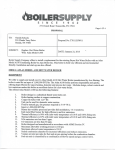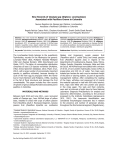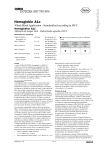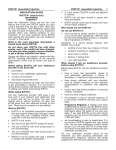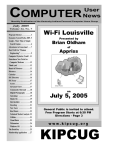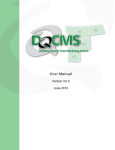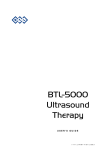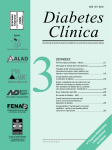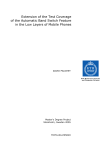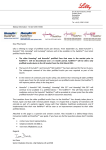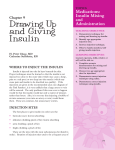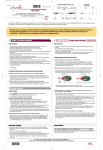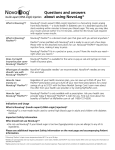Download Venekamp (HumaPen® Memoir™).fm
Transcript
Device Profile HumaPen® Memoir™: a novel insulin-injecting pen with a dose-memory feature Debra A Ignaut and Willem JRR Venekamp† CONTENTS HumaPen® Memoir™ Postmarketing findings Alternative pens/devices & how the technology fits into the field of medical devices Study conclusions Expert commentary Five-year view Information resources Financial & competing interests disclosure Key issues References Affiliations † Author for correspondence Atrium Medical Center, Brunssum, Kochstraat 2, 6442 BE, The Netherlands Tel.: +31 455 279 202 Fax: +31 455 279 477 [email protected] KEYWORDS: diabetes mellitus, injectors, insulin, insulin injection devices, pen devices www.future-drugs.com Optimizing glycemic control may help to reduce the risks of diabetes complications, but it is often difficult to achieve, partly owing to poor treatment adherence. One barrier to adherence is forgetfulness. The HumaPen® Memoir™ pen is the only electronic reusable insulin pen with a multiple-dose memory feature. This enables the device to store information regarding dates and times of the previous 16 doses of insulin, including priming doses. The pen has a digital display and a two-way dial to minimize waste of insulin. The digital display facilitates accurate dose selection. Both patients and healthcare providers rate as important the pen’s ability to confirm administered doses and times, its overall ease of injection and display readability, and its minimal waste when adjusting dose settings. Expert Rev. Med. Devices 4(6), 793–801 (2007) In patients with Type 2 diabetes mellitus (T2DM), suboptimal treatment adherence is a major impediment to achieving optimal blood glucose control and is, therefore, an important target for disease management [1,2]. Meta-analyses suggest that increased glycemic exposure is associated with heightened cardiovascular risk [3,4]. Findings from the European Prospective Investigation into Cancer in Norfolk (EPIC-Norfolk) study showed that, for every 1.0% rise in hemoglobin (Hb) A1c above 5.0%, there was a 20% increased risk of cardiovascular disease [5]. In addition, findings from the UK Prospective Diabetes Study (UKPDS) suggest that any decline in HbA1c was likely to decrease the risk of microvascular complications and, at HbA1c values of less than 6.0%, there was no lower threshold below which further lowering did not decrease the risk of complications [6]. However, nonadherence to antidiabetic treatment is common – approximately one in every three patients with T2DM are not adherent to their insulin regimens [7], and according to one estimate in the USA, only 37% of diabetes mellitus (DM) patients achieve the consensus target of HbA1c less than 7.0% [8]. Adherence to antidiabetes treatments (including lifestyle modifications) is often challenging, in part because treatment may be 10.1586/17434440.4.6.793 viewed as inconvenient and/or associated with adverse effects (e.g., weight gain, hypoglycemia or edema) [9]. Forgetfulness also appears to be an important barrier to DM treatment adherence in many patients. In a masked study of 3234 patients at high risk of developing DM, the most common reason for nonadherence to treatment with the biguanide metformin (or placebo) reported by patients was forgetting to take doses (22%) [9]. In this study, self-reported forgetting was associated with a more than fivefold increased risk of nonadherence (odds ratio [OR]: 5.11; 95% confidence interval [CI]: 4.30–6.07; p < 0.0001). The use of a vial and syringe for delivering insulin has several potential disadvantages that may compromise medication adherence. Many patients find the vial-and-syringe cumbersome and difficult to transport. Others experience anxiety, fear and/or social embarrassment, or object to the training time required to master the technique of insulin delivery via vial-and-syringe [10]. Introduced in 1987 in the USA, insulininjection pen devices were developed as alternative devices to promote patient satisfaction with, and adherence to, treatment and, thus, enhance glycemic control and overall treatment outcomes [11]. © 2007 Future Drugs Ltd ISSN 1743-4440 793 Ignaut & Venekamp The HumaPen® Memoir™ (HPM; Eli Lilly, IN, USA) is an electronic reusable pen for use with prefilled cartridges with a memory feature [12]. This enables the pen to store information on the previous 16 doses, including the priming doses, as well as the dates and times of dosing. A total of 16 doses represents at least approximately 2 days of use in a patient on intensive insulin treatment. The pen device also has a digital display and two-way dial to minimize any waste of insulin. A potential advantage of the HPM is the ability to check previous insulin doses, including their dates and times. The digital display also facilitates accurate dose selection. This article focuses on the HPM, a novel insulin-injection system (pen) associated with high acceptance in DM patients. HumaPen® Memoir™ The state of science in insulin pens/devices for diabetes mellitis insulin doses in a study of 48 subjects, with absolute errors of the mean ± standard deviation (SD) of 9.9% ± 2.4% versus 4.9% ± 1.6% (p < 0.001) [19]. Among patients with visual and/or motor disabilities, use of a pen may be particularly beneficial over vialand-syringe. In one study involving 79 patients, a higher proportion of patients with disabilities were able to self-administer insulin independently using a pen (53%) compared with vial-andsyringe (20%) [20]. Using the HPM The HPM is designed for the patient to self-administer 1–60 U of any Humalog® or Humulin® insulin from a 3-ml cartridge of 100 IU/ml (FIGURE 1). Doses are dialed one unit at a time and may be corrected without wasting insulin. HPM also has a dose-memory feature indicating the time, date and doses of the 16 previously delivered insulin treatments, including the priming doses. HPM is designed for 3 years of use with replaceable cartridges. After 3 years, to alert the patient that a replacement pen is needed, the battery symbol will flash when there are 3 weeks of battery life remaining. In clinical trials, patients with DM preferred pens to vial-andsyringe for self-administering insulin. Patient preferences for insulin pens have been ascribed to ease of use, lack of interference with activity, as well as enhanced social acceptability, convenience, flexibility, effectiveness and quality of life [13,14]. Many patients also find pens to be more discreet and accurate, less prominent Step 1: setting time & date sources of fear and pain, and more consistent with adherence The time and date are set by pressing the ON button to put than vial-and-syringe. Preferences for pen devices may predict the the pen in READY MODE. The time setting mode is then kind and nature of insulin prescribed in some countries (e.g., The entered by pressing and holding the ON button again for 3 s. When the hour number starts flashing, the dose knob is Netherlands and Germany). In a randomized, open-label, crossover trial involving pressed and released to set the correct hour. To enter another 121 patients, significantly higher proportions preferred an time or date mode, the ON button is pressed repeatedly until insulin pen over vial-and-syringe (74 vs 20%) and reported the that mode is flashing. To save time and date settings, press the pen to be more discreet (85 vs 9%) and easier to use (74 vs ON button to return to the READY MODE. 21%) [15]. In two multicenter surveys involving 1310 users of either an insulin pen or vial-and-syringe, up to 98% of patients Step 2: loading a cartridge responded that the pen was easier to use. Among a subset of Pull off the pen cap, unscrew the cartridge holder from the pen pen users (n = 456), 73% found it to be more accurate than body and insert the small end of the cartridge into the carvial-and-syringe, and 77% associated it with easier adherence to tridge holder. Use the cartridge plunger to push the injection treatment [16]. Other randomized, open-label, crossover Insulin Injection Pen Dose studies have demonstrated that use of an Cartridge viewing screw On button body knob holder Cap slot insulin pen was associated with a significantly lower rate of injection pain (p = 0.0018) and significantly higher rates of acceptance (p = 0.0059), ease in setting and drawing up insulin doses (p = 0.0490) Display Foot and preference (89.5%) compared with Display symbols vial-and-syringe among 96 initially insulinPM naive patients [17]. In a recent prospective, Time indicator Dose randomized, open-label, crossover study Rubber involving 162 patients, the use of an insuCartridge Paper Outer Inner seal plunger lin pen was also associated with a signifitab needle needle Lilly 3 ml cantly reduced fear of self-injection (9.5 vs Check cap cap Needle insulin Date Battery mark 11.2% with vial-and-syringe; p < 0.0001) cartridge Needle parts and insulin cartridge [18]. Most patients (71.5%) preferred the insulin pen. Compared with an insulin vial-and-syringe, an insulin pen was also Figure 1. Components of the HumaPen® Memoir™ insulin-delivery system. Needle parts and insulin found to be more accurate in delivering low cartridge sold separately. 794 Expert Rev. Med. Devices 4(6), (2007) HumaPen® Memoir™ screw back, and with the cartridge holder aligned straightly with the pen body, screw the cartridge holder onto the pen body. MODE, after ‘End’ is displayed, press the dose knob again. Otherwise, if the dose knob is not pressed, the pen will return to READY MODE automatically after 15 s. Step 3: preparing & priming the pen Care, storage & disposal Confirm the insulin type by reading the cartridge label through the insulin viewing slot. If the insulin is cloudy, roll the pen between the hands gently ten times and invert it ten times until the insulin appears evenly mixed. Clean the rubber seal at the end of the cartridge with an alcohol swab. To attach a needle, remove the paper tab from the outer needle cap, screw the outer needle cap onto the cartridge holder until completely attached, and pull off the outer needle cap and set aside. Turn on the pen by pressing the ON button. After 3 s, the display should return to READY MODE, indicating time, date and ‘0’. Prime the pen before each injection to check insulin flow and remove air. To prime the pen, turn the dose knob to 2 U, pull off the inner needle cap and discard, and hold the pen with the needle tip upward and away from the face. Tap the insulin cartridge holder gently with a finger to allow bubbles to collect near the top, and then slowly push the dose knob. Continue to hold the dose knob for another five counts after it stops moving. Priming is complete when a stream of liquid flows from the needle tip and the display is in READY MODE. The HPM pen should be kept away from dust, extreme heat or cold, or direct sunlight. The pen and its case should also be kept away from water, moisture or wet surfaces. The pen should not be refrigerated. The pen cap, pen body and case may be cleaned with a water-dampened cloth (without alcohol or bleach). Pen parts should not be lubricated with oil or any other lubricant. Pen needles and pens, which contain lithium batteries, should be discarded according to local regulations. Pen batteries cannot be replaced. Step 4: setting & injecting the insulin dose The desired dose is set by turning the dose knob. If too many units are set, the dial may be turned back to the desired dose without wasting insulin. To inject insulin, insert the needle into the injection site and then, with the thumb placed directly on the dose knob, slowly push the dose knob until five counts after the dose knob stops. Then remove the needle from the injection site. The pen should be in READY MODE. If it is not, an incomplete dose was administered, and the number displayed on the pen is the amount that failed to be administered. Dial down the dose knob to 0, and the partial dose is saved in the memory. Replace the cartridge and review the instructions above to inject the remaining dose. The memory feature will record the second partial dose as a separate dose. Upon completing the injection, replace the outer needle cap, unscrew the capped needle, remove it from the pen and discard. Replace the pen cap. The pen will turn off automatically after 30 s of inactivity. Removing an insulin cartridge When an insulin cartridge is empty, the needle may be removed, the cartridge holder unscrewed and removed from the pen body, and the empty insulin cartridge removed by tilting the cartridge holder. Viewing dose memory With the pen in READY MODE, press and release the dose knob to reveal the most recent dose first. To see all stored doses, press the dose knob repeatedly. To return to READY www.future-drugs.com Cost–effectiveness Compared with vial-and-syringe, the use of insulin pens in general is cost effective. In a longitudinal retrospective study of 1156 US adults with T2DM initiating insulin treatment with a pen device, adherence increased significantly (compared with vial-and-syringe). This conclusion emerged from assessments of first, the medication possession ratio (MPR) (mean [SD] MPR 69% [33%] vs 62% [28%]; p < 0.01), and second, proportions of patients with MPR of 80% or above (54.6 vs 36.1%; p < 0.01) [10]. Compared with vial-and-syringe, use of an insulin pen also reduced the risk of hypoglycemic events significantly (OR: 0.36; 95% CI: 0.25–0.53; p < 0.05) and of experiencing a hypoglycemic event (OR: 0.50; 95% CI: 0.37–0.68; p < 0.05). Consistent with these findings, mean annual healthcare costs also declined significantly, from US$16,359 with vial-and-syringe to $14,769 with the pen (p < 0.01) [10]. Clinical profile: results of a human study involving HPM For approval, regulatory authorities do not require that manufacturers conduct clinical trials of pen devices. However, in a multicenter trial supported by the manufacturer of the HPM, the pen device was effective, well tolerated and well accepted by outpatients with DM. In this 6- to 10-week open-label, single arm, outpatient study, HPM demonstrated acceptable functionality and a favorable benefit-risk profile as reported by 300 patients and 16 healthcare providers [12]. Study objectives & characteristics of patients The primary objective of the study was to determine whether HPM has acceptable functionality (ability to deliver a prespecified dose of insulin) according to patient diaries. This study also assessed the pen-device safety and acceptability. The trial included 300 adults with a mean (SD) age of 51.7 (14.6) years (range: 18.0–75.5 years), who had Type 1 DM (T1DM; 38%) or T2DM (62%) for a mean (SD) of 13.7 (9.0) years (range: 0.4–55.0 years). Patients were recruited from 21 sites in India, South Africa, Germany and The Netherlands, and were of various racial origins: 84.7% Caucasian, 15.0% Western Asian and 0.3% African [12]. 795 Ignaut & Venekamp A Percentage agree or strongly agree Percentage rating easy or very easy B 0 10 20 30 40 50 60 70 80 90 100 Easy to see dose of insulin used Easy to select dose Easy to control blood sugar Easy to carry for use away from home Does not interfere with short trip plans Easy to fit into daily life Not noticeable to others when used Reduces embarrassment when used away from home 79 93 97* Learning to use the pen 92* Using power button 84 to turn pen on 96* Ability to read 51 time and date 65 p < 0.001 Ability to read dose 67 60 Setting time and date 83 * Attaching/removing 83 cartridge holder 72 Holding pen 80* while injecting 41 43 98 91 81 70 80* 55 54 Viewing doses in memory Understanding display messages 91 71 91 Using the quick guide 94 96 * 91 Overall ease of use Prestudy pen (visit 1) 97* 91 89* 92 97* 97 Using the user manual 80 79 75 74 98* 78 76 Injecting dose 54 48 Convenient to use Reduces my reluctance to take injections Helps me manage my diabetes at home Helps me manage my diabetes away from home 0 10 20 30 40 50 60 70 80 90 100 HumaPen® Memoir™ (final visit) Figure 2. Study patients’ ratings of the prestudy pen device compared with the HumaPen® Memoir™ pen device. (A) At study completion, patients (n = 290) rated device properties using a scale of 1 (strongly disagree) to 6 (agree) or 7 (strongly agree). Each bar represents the percentage of patients responding with a 6 or 7. p values were computed from the proportional-odds model (cumulative logits) using the ordinal response scale (1–7) and hence are based on comparisons of actual scores (1–7), not the percentage of patients who agreed with the statements (response of 6 or 7). (B) Patients rated device properties using a scale of 1 (very difficult) to 4 (easy) or 5 (very easy) or ‘not applicable.’ Each bar represents the percentage of patients rating the task as a 4 or 5. p values were computed from the proportional-odds model (cumulative logits) based on comparisons of actual scores (1–5) and did not include responses of ‘not applicable.’ The p values are hence based on comparisons of actual scores (1–5), not the percentage of patients rating the task easy (response of 4 or 5).For (A) and (B) *p < 0.05 indicate significant differences in scales between responses concerning prestudy pens (at study baseline) and the HumaPen® Memoir™ (at study completion). Reproduced with permission from [12] and CMRO Informa Healthcare. Eligible patients had been using an insulin-injection device for at least two insulin doses per day for 2 months or longer immediately before the study. The mean (SD) duration of use of an insulin injection device at baseline was 7.1 (5.9) years (range: 0.25–40.0 years). Most patients had been using the HumaPen Ergo (Eli Lilly; 63.1%) or the OptiPen Pro® (SanofiAventis, NJ, USA) series (19.2%). Study patients were required to use, as their prandial insulin, an Eli Lilly product: insulin lispro (Humalog), insulin lispro low mix 25 (LM25; Humalog Mix25™), and/or insulin lispro mix 50 (LM50; Humalog Mix50™). If using insulin lispro for most prandial injections, patients were required to use as their basal insulin either human insulin isophane suspension (NPH; Humulin N) or insulin glargine (Lantus®; Sanofi-Aventis) [12]. Methods At the first of three office visits over 6–10 weeks, patients were assigned to use HPM for either their prandial or basal insulin. To ensure sufficient use of the pen in the study, patients using 796 NPH were stratified in a 3:2 ratio to receive prandial or basal insulin. To minimize the impact of prestudy insulin formulation and dose, patients using insulin glargine were assigned to continue insulin glargine with their prestudy insulin injection device and use of the HPM pen device for prandial doses. Patients used the same dosing schedule and insulin doses that had been used immediately before study onset. Dose adjustment was permitted as needed [12]. At the first (baseline; prestudy pen device) visit, patients recorded complaints regarding HPM (or the accompanying User Manual) in their diaries, which were reviewed by investigators at the third and final (6–10 weeks after baseline) visit. Complaints could also be reported by telephone to the investigative site. Complaint forms were completed and submitted for each complaint. If the investigator believed that the adverse events were related to the study pen, complaint forms were submitted regardless of whether the complaint was reported by the patient. The study sponsor categorized each complaint as functional, nonfunctional or related to the User Manual [12]. Expert Rev. Med. Devices 4(6), (2007) HumaPen® Memoir™ Functional complaints were defined as those interfering with the ability of the study pen to deliver a prespecified insulin dose as well as pen malfunction due to improper use. Nonfunctional complaints did not concern the pen device’s functionality (e.g., aesthetic concerns). Complaints were also categorized according to answers to specific questions about each complaint and free-form descriptions of complaints. In addition, complaints were categorized based on information within the complaint forms and when applicable, assessment of the pen device [12]. To assess HPM pen safety, patients recorded any device-related hypoglycemic episodes (blood glucose < 3.5 mmol/l [63 mg/dl] or signs/symptoms of hypoglycemia), hyperglycemic episodes (blood glucose > 18 mmol/l [324 mg/dl]), or other adverse events. Glycemic control, HbA1c and fasting plasma glucose were measured at baseline and final visit. Patient satisfaction with preference for, and confidence in, HPM were measured using the Insulin Delivery System Evaluation questionnaire, an adaptation of the previously validated Insulin Injection Preference questionnaire [21]. Healthcare provider acceptance of the HPM pen device compared with other insulin injection devices was evaluated using a Health Care Professional Evaluation, an adaptation of the patients’ questionnaire. Results (one pen received both complaints). Of the 24 pen devices receiving functional complaints, eight (2.5%) were related to pen failure. A further 15 (4.8%) pen devices received complaints related to recoverable errors, possibly cleared by manually resetting the pen. No functional complaints resulted in a serious adverse event. Of the 33 pens receiving nonfunctional complaints, many were attributed to user misunderstanding of pen operation (9/33 [27.3%]; 2.9% of all 314 pens), recoverable errors (5/33 [15.2%]; 1.6%), or esthetic issues (7/33 [21.2%]; 2.2%) [12]. Insulin delivered via the HPM was well tolerated. Between baseline and final visit, patients maintained glycemic control, with no significant changes in mean HbA1c levels or mean fasting plasma glucose levels. Only three treatment-emergent events occurred in over 2% of patients: influenza (4.7%), nasopharyngitis (4.3%) and headache (2.3%). There were no treatment-related serious adverse events and no discontinuations due to adverse events. A hypoglycemic event occurred in 106 patients (0.94 event per patient per 30 days). No HPMrelated hypoglycemic events were reported. Instances of hyperglycemia (blood glucose ≥ 18 mmol/l) potentially related to use of the HPM pen device were reported twice in one patient but were later determined to have resulted from incorrect needle insertion [12]. Among 290 patients completing questionnaires, 77.9% were satisfied with the HPM pen device compared with 54.2% with their prestudy device. A total of 81.4% of patients preferred the HPM compared with only 18.6% preferring their prestudy HPM was used for the basal dose by 11.3% of patients and for the prandial dose by 88.7%, of whom 76.0% used it to administer insulin lispro, 10.7% for LM25 and 2.0% for LM50. The mean (SD) duration of use for the HPM pen device was 8.2 (1.6) weeks for a total exposure of 2446 person-weeks. The HPM pen was used to administer mean (SD) daily doses of 24.6 Percentage (12.3) U for the basal dose and 28.5 0 10 20 30 40 50 60 70 80 90 100 (20.2) U for the prandial dose. A backup 38 Ability to view the number of insulin-injection device was used in place 44 units of previous insulin dose of the HPM pen because of difficult use 25 Ability to view the time of for 7 or more consecutive days by only 7 44 previous insulin dose (2.3%) patients. The HPM pen was Ability to view the date of 5 replaced with another insulin-injection previous insulin dose 0 device by 14 (4.7%) patients [12]. Ability to view the previous 23 Numbers of functional and nonfunctional 19 16 doses complaints reported by patients in the basal 16 versus prandial treatment groups, and in the Ability to view previous dose information 25 to make current dose decision simple versus complex insulin regimen 55 Ability to confirm injection taken groups, were similar (p > 0.14 for all com63 parisons). Functional complaints were Ability to use information to fill out 14 reported by 13.3% of subjects from The blood-glucose logbook 6 Netherlands, 11.5% from South Africa, 15 Memory feature not important 10.7% from India and 2.7% from Germany. 0 Study participants Nonfunctional complaints were reported by Healthcare providers 2 Other 23.1% of subjects from South Africa, 10.8% 0 from The Netherlands, 10.7% from India and 6% from Germany [12]. Figure 3. Most important aspects of the memory feature of HumaPen® Memoir™ pen device Of 314 HPM pens, 56 (17.8%) selected by study patients and healthcare providers. At study completion, study patients (n = 290) and received complaints; 24 (7.6%) were func- HCP (n = 16) selected two aspects of the memory feature thought to be most important. Reproduced with tional and 33 (10.5%) nonfunctional permission from [12] and CMRO Informa Healthcare. www.future-drugs.com 797 Ignaut & Venekamp device. Compared with prestudy pens, the HPM pen device high ratings from patients and healthcare providers across sevreceived better patient ratings for ease of seeing the insulin eral dimensions, including ease of use. Most healthcare providdose used, selecting the dose, injecting the dose, controlling ers (88%) reported that the average time required to train a blood glucose level, attaching and removing the cartridge patient in HPM pen device use was less than 30 min, and 50% holder, and convenience (FIGURES 2 A & B). Patients identified reported that this training required less than 15 min [12]. HPM’s memory-feature functions as important, including Future studies are necessary to further assess healthcare proability to confirm that an injection was taken as well as to viders’ perceptions of the HPM, and assess the pen in more natindicate the previous insulin dose, time of dosing and previ- uralistic clinical settings, in which patients may not receive ous 16 doses (FIGURE 3). Less than 50% of patients did not thorough training. select, as one of the two most important aspects of the memory feature, the ability to view previous dose information to Postmarketing findings make a current dose decision. This value may represent an The HPM received favorable feedback and no significant underestimation because of selection of other, more general complaints in postmarketing findings collected in The Nethaspects listed in the questionnaire that may be interpreted as erlands. The main reported advantages of the HPM pen were including this aspect; for example, the ability to view the pre- its ease of use, appearance and dose-memory function, which vious 16 doses, ability to view time of previous insulin dose, was appreciated as a means of promoting diabetes manageand ability to view number of units of previous insulin dose. ment. Other reported advantages were the easy-to-read disUpon study completion, 87% of patients reported that they play, ease of injection and screw-on cartridge holder. The would use the HPM pen device again or recommend it to others, primarily for Percentage ease of use/injection, the memory fea0 10 20 30 40 50 60 70 80 90 100 ture, ease of reading numbers, the clear 87 digital display, and the ability to dial Would use/recommend 100 back easily without wasting insulin 2 (FIGURE 4) [12]. Size 0 Similar results were reported by healthStudy participants 1 care providers (FIGURES 3 & 4). Their ratings Weight 6 Healthcare providers of HPM pens compared with prestudy 12 devices were similar to patients’ ratings. Appearance 6 Compared with the most commonly used 69 prestudy devices, the HPM pen received Easy to use 50 significantly higher ratings of ‘easy’ or 39 ‘very easy’ for ability to read dose (100 vs Easy to read numbers 31 84%) and injecting dose (100 vs 90%; 26 both p < 0.05 for comparisons of scores Digital display 31 from 1 [very difficult] to 4 [easy] or 5 43 Easy to push the dose knob/inject [very easy]). 38 These findings demonstrate that HPM Can dial back easily 22 pen had acceptable functionality in an without wasting insulin 56 outpatient setting in patients with T1DM 8 Easy to carry or T2DM. Of 314 pens, 24 (7.6%) 0 received complaints regarding functional8 Easy to teach 6 ity, of which 8 (2.5%) were related to pen device failure. No pens receiving func54 Memory feature 75 tional complaints resulted in a serious adverse event, there were no pen-related 9 Easy to hold hypoglycemic events, and two hyper0 glycemic events considered possibly 6 Other 0 related to the pen device were later attributed to incorrect needle insertion. Most patients were satisfied with the HPM pen Figure 4. Top reasons selected by study patients and healthcare providers (HCP) for using or device, preferred it to their previous recommending the HumaPen® Memoir™ pen device. At study completion, study patients (n = 290) and injection device and stated that they HCP (n = 16) reported whether or not they would use or recommend the HumaPen Memoir pen device and would use the HPM pen again or recom- selected three reasons for using/recommending it. mend it. The pen received convergently Reproduced with permission from [12] and CMRO Informa Healthcare. 798 Expert Rev. Med. Devices 4(6), (2007) HumaPen® Memoir™ HPM received high ratings for ease of use and for appearance. The most common reported disadvantages of the HPM were premature failure of the battery or electronics and the pen size. However, these reports were not prevalent and there were no safety concerns. HumaPen Ergo (75%) or Novolin® Innolet® (90%). The HPM is unique in being a reusable insulin pen with a dosememory feature. The HPM also offers the potential advantages of a digital display and a two-way dial to minimize any waste of insulin. Several prefilled disposable insulin injection devices are also available (TABLE 1). Alternative pens/devices and how the technology fits into the field of medical devices Study conclusions Several reusable insulin injection devices are available ® (TABLE 1). According to Clarke and Dain, the OptiClik (Sanofi-Aventis) facilitates cartridge changing, has a clear dose display and enables large doses of insulin to be delivered with a single injection [22]. For a dialed dose of 80 U, the OptiClik delivered a mean dose of 79.75 ± 0.32 U under ambient conditions [22]. The NovoPen® 3 (Novo Nordisk, NJ, USA) also offers the potential advantage of a high degree of auditory confirmation of dose setting [23]. In a trial involving 48 patients, significantly higher proportions of patients detected an auditory confirmation of dose setting with the NovoPen 3 (100%) compared with the Humalog Pen (63%), In a clinical trial, HPM pen was effective, acceptable to (and preferred by) most patients over their previous insulin-injection devices and associated with high treatment satisfaction. The majority of patients stated that they would use the HPM again or recommend it to another patient. Most patients rated the memory feature as being among the top reasons for recommending the HPM (ease of use being the other), and the ability to confirm injections taken as the most important aspect of the dose-memory feature. The HPM pen device also received convergently high ratings from healthcare providers across several dimensions, including ease of use. Table 1. Comparison of insulin pens. Device Reusable? Prefilled? Can dial forward and backward without wasting insulin? Maximum dose and dose increments Multiple-dose memory function? HumaPen® Memoir™ Yes No Yes 60 units (1 unit increments) Yes (16 with date and time) HumaPen® Ergo* Yes No Yes 60 units (1 unit increments) No ® HumaPen Ergo II Yes No Yes 60 units (1 unit increments) No HumaPen® Luxura™ Yes No Yes 60 units (1 unit increments) No HumaPen® Luxura HD Yes No Yes 30 units (0.5 unit increments, 1–30 units) No Humulin® or Humalog® Pen No Yes Yes 60 units (1 unit increments) No NovoPen® 3 Yes No No 70 units (1 unit increments) No NovoPen® 4 Yes No Yes 60 units (1 unit increments) No NovoPen® Junior Yes No No 35 units (0.5 unit increments, 1–35 units) No Novolin® Innolet No Yes No 50 units (1 unit increments) No Novo FlexPen® No Yes Yes 60 units (1 unit increments) No Yes No No 80 units (1 unit increments) No Yes No No 21 units (1 unit increments) or No 42 units (2 unit increments) No Yes No 40 units (2 unit increments) No No Yes Yes 80 units (1 unit increments) No ® OptiClik ®‡ AutoPen Lantus® OptiSet® ® ® Lantus SoloStar A summary of comparative features (from product manuals) of insulin pen devices. The table may not be inclusive of all such devices currently available in certain markets. *Being discontinued in 2007. ‡ Owen Mumford device used with Sanofi–Aventis insulins in some markets. www.future-drugs.com 799 Ignaut & Venekamp Expert commentary There is a growing need for insulin therapy to optimize metabolic control. Therefore, a simple and reliable way to administer insulin is a priority. The HPM has several advantages over conventional vial-and-syringe and other available insulin pen injectors. One key advantage of the HPM is its memory function, which provides a unique tool for promoting patient adherence to insulin therapy. Five-year view Mechanical insulin pen injectors are at a very mature phase of evolution and can be differentiated in development only by minor improvements in what are seen as standard features, as well as in industrial-design options. Electromechanical insulin-injection pen devices, while mature in their mechanical functionality, may still present new opportunities for innovation in electronic feature sets and communication of data wirelessly and remotely. One possible area for future innovation might be to increase the number of doses stored in memory, particularly for patients using complex or intensive insulin regimens. Of course, the value that such innovations offers to the patient and healthcare provider comes at a cost. The ability to measure improvements in health-related quality-of-life outcomes will be critical in gaining reimbursement for innovations in electromechanical insulin injection systems. Devices for alternative routes of insulin administration (i.e., insulin-inhalation devices) do not currently appear to impact the insulin pen market but may play a more prominent role in the future. • International Diabetes Federation www.idf.org • National Diabetes Education Initiative www.ndei.org • National Institute of Diabetes and Digestive and Kidney Diseases www2.niddk.nih.gov • HumaPen® Memoir™; further information www.humalog.com/patient/humapen_memoir.jsp • Autopen® www.owenmumford.com/autopen.html • Humalog® Pen (insulin lispro injection USP [rDNA origin] 100 units per mL [U-100]) prescribing information. Eli Lilly and Company, IN, USA. Eli Lilly and Company, 2007 www.humalog.com • Humalog® Mix75/25™ Pen (75% insulin lispro protamine suspension and 25% insulin lispro injection [rDNA origin] 100 units per mL [U-100]) prescribing information. Eli Lilly and Company, IN, USA. Eli Lilly and Company, 2007 www.humalog.com • Humalog® Mix50/50™ Pen (50% insulin lispro protamine suspension and 50% insulin lispro injection [rDNA origin] 100 units per ml [U-100]) prescribing information. Eli Lilly and Company, IN, USA. Eli Lilly and Company, 2007 www.humalog.com Information resources • Lantus® (insulin glargine [rDNA] injection) prescribing information. Sanofi-Aventis, NJ, USA. Sanofi-Aventis US LLC, 2006 www.lantus.com • American Diabetes Association www.diabetes.org • Novopen® 3 www.insulindevice.com/novopen/ • European Association for the Study of Diabetes www.easd.org • OptiClik® www.opticlik.com/home.do Key issues • Diabetes mellitus (DM) is a leading cause of morbidity, mortality and healthcare costs. • Tight glycemic control is instrumental in reducing the risk of complications of DM, but it is often difficult to achieve because of suboptimal adherence. • Forgetfulness is a major contributing factor to suboptimal adherence with insulin regimens. • The HumaPen® Memoir™ (HPM) is an electronic reusable insulin pen device with a memory function to store the dates, times and doses of up to 16 previous insulin injections, including priming doses. • In a clinical study, the HPM demonstrated acceptable functionality and tolerability, and its memory option was highly valued by patients. • The HPM received convergently high ratings from patients as well as healthcare providers, with the majority of patients preferring the HPM to their previous insulin injectors and stating that they would use it again or recommend it to other patients. 800 Expert Rev. Med. Devices 4(6), (2007) HumaPen® Memoir™ Financial & competing interests disclosure Both authors participated in the development and review of this manuscript before it was submitted. Debra Ignaut, RN, CDE, is an employee and stockholder of Eli Lilly. Willem JRR Venekamp, MD, is a member of a European Advisory Board for Eli Lilly and serves as a speaker for Novo Nordisk. All clinical trials for Eli Lilly products mentioned herein were funded by Eli Lilly and Company. Eli Lilly and Company, Battelle Science and Technology International and Nypro Inc. collaborated in the development of HumaPen® Memoir™. The authors have no other relevant affiliations or financial involvement with any organization or entity with a financial interest in or financial conflict with the subject matter or materials discussed in the manuscript apart from those disclosed. Assistance in manuscript preparation was provided by Stephen W Gukin, Rete Biomedical Communications Corp. (Ridgewood, NJ, USA). The authors also wish to acknowledge Margaret Campbell and Cate Jones, PhD, of Eli Lilly and Company for their review of the manuscript. References Papers of special note have been highlighted as: • of interest •• of considerable interest 8 Saydah SH, Fradkin J, Cowie CC. Poor control of risk factors for vascular disease among adults with previously diagnosed diabetes. JAMA 291, 335–342 (2004). Goldberg RB, Mellies MJ, Sacks FM et al. Cardiovascular events and their reduction with pravastatin in diabetic and glucoseintolerant myocardial infarction survivors with average cholesterol levels: subgroup analyses in the Cholesterol and Recurrent Events (CARE) trial. Circulation 98, 2513–2519 (1998). 9 Walker EA, Molitch M, Kramer MK et al. Adherence to preventive medications: predictors and outcomes in the Diabetes Prevention Program. Diabetes Care 29, 1997–2002 (2006). Emphasizes the importance of adherence to treatment, and the key role of memory in fostering adherence. Demonstrates that adherence to metformin treatment reduces the risk of developing diabetes mellitis (DM). The most common reported reason for nonadherence was ‘forgetting’ (> 20%). 1 2 Gerstein HC. Glycosylated hemoglobin: finally ready for prime time as a cardiovascular risk factor. Ann. Intern. Med. 141, 475–476 (2004). 3 Selvin E, Marinopoulos S, Berkenblit G et al. Meta-analysis: glycosylated hemoglobin and cardiovascular disease in diabetes mellitus. Arch. Intern. Med. 141, 421–431 (2004). 4 Coutinho M, Gerstein HC, Wang Y, Yusuf S. The relationship between glucose and incident cardiovascular events: a metaregression analysis of published data from 20 studies of 95,783 individuals followed for 12.4 years. Diabetes Care 22, 233–240 (1999). 5 6 7 •• •• Khaw K-T, Wareham N, Bingham S, Luben R, Welch A, Day N. Association of hemoglobin A1C with cardiovascular disease and mortality in adults: the European Prospective Investigation into Cancer in Norfolk. Ann. Intern. Med. 141, 413–420 (2004). Stratton IM, Adler AI, Neil HAW et al. Association of glycaemia with macrovascular and microvascular complications of Type 2 diabetes (UKPDS 35): prospective observational study. Br. Med. J. 321, 405–412 (2000). Cramer JA. A systematic review of adherence with medications for diabetes. Diabetes Care 27, 1218–1224 (2004). Demonstrates a limited rate of adherence to oral hypoglycemic agents and to insulin, indicating the need for an electronic monitoring system to improve treatment adherence. www.future-drugs.com 10 •• Lee WC, Balu S, Cobden D, Joshi AV, Pashos CL. Medication adherence and the associated health-economic impact among patients with Type 2 diabetes mellitus converting to insulin pen therapy: an analysis of third-party managed care claims data. Clin. Ther. 28, 1712–1725 (2006). Demonstrates that, in patients with Type 2 Diabetes Mellitis (T2DM), switching from insulin delivery by vial-and-syringe to a pen improves adherence and health outcomes and reduces annual costs of treatment. 11 Stewart KM, Wilson MF, Rider JM. Insulin delivery devices. J. Pharm. Pract. 17, 20–28 (2004). 12 Venekamp WJRR, Kerr L, Dowsett SA et al. Functionality and acceptability of a new electronic insulin injection pen with a memory feature. Curr. Med. Res. Opin. 22, 315–325 (2006). Demonstrates that the HumaPen® Memoir™ has favorable functionality; higher patient and healthcare provider ratings of acceptability compared with prestudy pens; and a high rate of preference to prestudy pens, largely because of the pen’s dose-memory function. •• 13 Summers KH, Szeinback SL, Lenox SM. Preference for insulin delivery systems among current insulin users and nonusers. Clin. Ther. 26, 1498–1505 (2004). • Demonstrates that, among patients with Type 1 (T1)DM or T2DM, including current insulin users and nonusers, insulin-delivering pens were preferred to vial-and-syringe because of greater social acceptability with pens. 14 Rubin RR, Peyrot M. Quality of life, treatment satisfaction, and treatment preference associated with use of a pen device delivering a premixed 70/30 insulin aspart suspension (aspart protamine suspension/soluble aspart) versus alternative treatment strategies. Diabetes Care 27, 2495–2497 (2004). 15 Korytkowski M, Bell D, Jacobsen C, Suwannasari R. A multicenter, randomized, open-label, comparative, twoperiod crossover trial of preference, efficacy, and safety profiles of a prefilled, disposable pen and conventional vial/syringe for insulin injection in patients with Type 1 and 2 diabetes mellitus. Clin. Ther. 25, 2836–2848 (2003). 16 Graff MR, McClanahan MA. Assessment by patients with diabetes mellitus of two insulin pen delivery systems versus a vial and syringe. Clin. Ther. 20, 486–496 (1998). 17 Kadiri A, Chraibi A, Marouan F et al. Comparison of NovoPen 3 and syringes/vials in the acceptance of insulin therapy in NIDDM patients with secondary failure to oral hypoglycaemic agents. Diabetes Res. Clin. Pract. 41, 15–23 (1998). 18 Stockl K, Ory C, Vanderplas A et al. An evaluation of patient preference for an alternative insulin delivery system compared to standard vial and syringe. Curr. Med. Res. Opin. 23, 133–146 (2007). Demonstrates that, for most patients with T1DM or T2DM, compared with vial-and-syringe, an alternative insulin delivery system is preferable and associated with less psychological distress. • 19 Lteif AN, Schwenk WF. Accuracy of pen injectors versus insulin syringes in children with Type 1 diabetes. Diabetes Care 22, 137–140 (1999). 801 Ignaut & Venekamp 20 Shelmet J, Schwartz S, Cappleman J et al. Preference and resource utilization in elderly patients: InnoLet versus vial/syringe. Diabetes Res. Clin. Pract. 63, 27–35 (2004). 21 Szeinbach SL, Barnes JH, Summers KH, Lenox SM. Development of an instrument to assess expectations of and preference for an insulin injection pen compared with the vial and syringe. Clin. Ther. 26, 590–597 (2004). 22 Clarke A, Dain MP. Dose accuracy of a reusable insulin pen using a cartridge system with an integrated plunger mechanism. Expert Opin. Drug Deliv. 3, 677–683 (2006). 802 23 Asakura T, Seino H. Assessment of dose selection attributes with audible notification in insulin pen devices. Diabetes Tech. Ther. 7, 620–626 (2005). Affiliations • • Willem JRR Venekamp, MD Consultant Endocrinologist, Atrium Medical Center, Brunssum, Kochstraat 2, 6442 BE, The Netherlands Tel.: +31 455 279 202 Fax: +31 455 279 477 [email protected] Debra A Ignaut, RN, CDE Clinical Research Advisor, Eli Lilly and Company, Diabetes/Endocrine Medical, Indianapolis, IN 46285, USA Tel.: +1 317 433 3330 Fax: +1 317 277 5458 [email protected] Expert Rev. Med. Devices 4(6), (2007)











